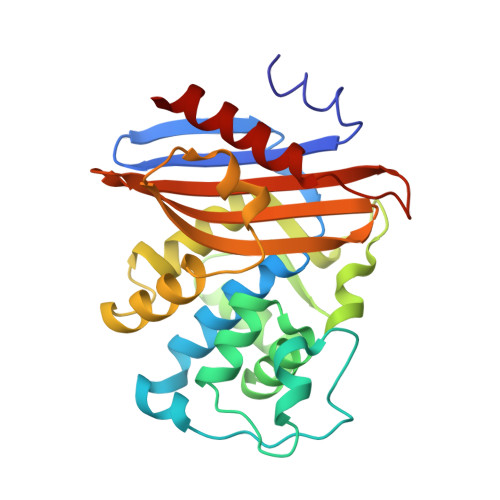A catalytically-impaired class A beta-lactamase: 2 A crystal structure and kinetics of the Bacillus licheniformis E166A mutant.
Knox, J.R., Moews, P.C., Escobar, W.A., Fink, A.L.(1993) Protein Eng 6: 11-18
- PubMed: 8433965
- DOI: https://doi.org/10.1093/protein/6.1.11
- Primary Citation of Related Structures:
1MBL - PubMed Abstract:
In the beta-lactamase (penicillinase) of Bacillus licheniformis 749/C, site specific mutation of Glu166 to Ala caused a million-fold reduction of catalytic activity towards both penicillin and cephalosporin substrates and resulted in the stoichiometric accumulation of the acyl enzyme. The rate of deacylation generally slowed by as much as 10(-7) compared to the wild type. The acyl enzyme intermediate was observed by HPLC, but not by X-ray diffraction. The mutant was crystallized from methoxyPEG 5000 at pH 6.2 in space group P2(1) with Z = 4. Molecular replacement based on the wild type structure followed by refinement produced an R factor of 17.2% for 25,800 3 sigma data from 10 to 2 A. Deviations from bond and angle ideals are 0.005 A and 1.5 degrees respectively. The mutant differs very little from the wild type structure, with only 0.25 A (r.m.s.) differences in backbone atoms; the CD spectra and thermal stabilities of the two enzymes are identical. Changes in the positions of the reactive Ser70 and conserved Lys73 are not significant, suggesting that the proposed salt linkage to Glu166 in the wild type enzyme is weak or non-existent. The calculated solvent exposure of Ser70 and Lys73 increases slightly and a buried water molecule is now positioned near Lys73. The hydrolytic water seen in the native active site shifts markedly by 1.6 A, but is held in the active site by Asn170, which possibly becomes an ineffective substitute for Glu166 in activating the water for deacylation.
- Department of Molecular and Cell Biology, University of Connecticut, Storrs 06269-3125.
Organizational Affiliation:

















